Patters
Manual treatments such as massage, bandages, chin straps and patters were used in early Beauty Culture to treat wrinkles, flabbiness and double chins. It was believed that these manual treatments – when used with appropriate skin foods, muscle oils, skin tonics or reducing creams – would benefit the skin in ways we would not accept today.
The use of manual treatments by medical practitioners, sanatoriums and health spas goes back centuries. As beauty salons came into being in the late nineteenth and early twentieth centuries, they adopted and adapted many of these manual practices along with others that used light, heat, water and electricity.
The patter
Patters came in different forms but generally consisted of a circular pad attached to a metal handle which was used to strike the face with a flicking action. This, it was believed, would improve circulation and thus would help firm the skin and reduce flabbiness. As wrinkles were considered by many to be lax skin folds, patters were also used to counteract wrinkles in combination with tissue creams, skin foods, skin tonics and/or astringents. Tissue creams or skin foods were supposed to build up underlying tissue while skin tonics and astringents were presumed to help counteract flabbiness by tightening muscles and skin.
See also: Skin Foods and Skin Tonics, Astringents &Toners
Mallets
Ruth Maurer – the founder of Marinello who published material under the name of Emily Lloyd – describes a type of patter she calls a mallet.
Some operators prefer keeping one mallet stationary while tapping with the other. Others declare it is best to use both at the same time. In actual practice, experience shows that both methods give good results. The tapping may be given more vigorously on the cheeks and beneath the chin, while about the eyes and on the forehead the lightest motions must be used. This work does much to keep the flesh firm, and though important as part of the treatment, need not consume more than four to six minutes. After it is finished the fingers should be rubbed carefully over the face and all suprefluous [sic] creme removed by the use of a bit of cotton. Powder should be dusted on as a protection from the air.
(McIntosh Battery and Optical Company, 1903, p. 26)
Although their function was similar to other patters, mallets appear to have been more like small, soft hammers in shape. They disappeared from Marinello textbooks in the 1920s.
Use
The direction in which the patters were used was important. As with massage movements in facials today, in order to avoid dragging the skin down, stimulation was applied upwards and outwards. They would have produced some localised flushing and oedema of the skin but the effects would have been temporary.
The small patting instruments are designed in various shapes but all have the same result—that is, stimulating the surface blood vessels, and bringing colour and warmth to the skin first, then filling out the hollows and making lumps of fatty tissue disappear.
Most of them are shaped like a spoon, with a flat round bowl, and are composed of rubber projections, like soft prickles. There are glass patters, which pat and smooth the face, and there are some made of horn-like substance; but all have handles which are held loosely between the thumb and two fingers, and with a flicking movement strike the face in sharp, even pats, which after a time resemble vibration. The direction of these pats must be guided upward and outward like all massage movements, or the flesh is driven downward and becomes flabby. A great deal of skill can be required in using these stimulating beauty aids, and as a tonic treatment they are extremely satisfactory but they cannot be expected to reach the deep seated muscles.(Verni, 1946, p. 66)
Elizabeth Arden and Dorothy Gray
Both Elizabeth Arden and Dorothy Gray used patters in their treatment plans. It would appear that Dorothy Gray picked up the technique from Elizabeth Arden who in turn got it from Eleanor Adair.
This treatments has as its foundation strapping the muscles, assisted by the finest of creams, tonics and an Eastern muscle oil. There is a cleansing cream to clean the pores, a skin food to feed them, and the muscle oil to brace up the relaxed muscles. All of these are applied to the skin by the strapping or patting motion. A similar effect can be produced at home by the patter—a chamois pad at the end of a spring—which the originator of the system has invented. Two pads, one for the tonic and the other for the cream, are included in an outfit selling for $5.00.
(Eleanor Adair advertorial, 1914)
Also see: Eleanor Adair
Elizabeth Arden patters
The first patter sold by Elizabeth Arden stuck to the basic design. It was to be used with ‘Ardena Skin Tonic’ and ‘Venetian Special Astringent’ to “to tighten the muscles and firm the contour”.
Cleansing: Make a cream-pad of cotton. Saturate with water, squeeze out, dip lightly into Ardena Skin Tonic. Now spread with Ardena Cleansing Cream and with firm upward strokes, sweep face and neck clean. Remove with Velva Cleansing tissues.
Toning: Make a tonic-pad of cotton. Dip into Ardena Skin Tonic. Now pat skin stingingly with brisk, climbing steps from the chin. Seven pats to temple, following facial contour, five pats to upper cheekbone. Three pats upside of mouth and nose, three gentle pats crosswise under eyes. Seven “cake-beating” pats on forehead. Finish with down stoke on nose.
Soothing: Use your fingers or Ardena Cream Patter. Apply Velva Cream liberally to face and neck. Blot off excess with Ardena Cleansing Tissues. Allow a thin film to remain on overnight, and at least 15 minutes in the morning.(Elizabeth Arden advertisement, 1935)
When Arden introduced a second patter she differentiated their use and gave each a separate name. The original patter was now called the ‘Ardena Astringent Patter’.

Above: Elizabeth Arden Ardena Astringent Patter
Invaluable for stimulating the circulation when applying Ardena Skin Tonic or Special Astringent. Cover the head of the Patter with a slight layer of moisten absorbent cotton. Secure with an elastic band and dip in Skin Tonic or Special Astringent. Then pat gently with upward movements … This Patter will be found wonderfully helpful in reducing a double chin and the lump which forms at the back of the neck.
(Elizabeth Arden promotional booklet, n.d.)
The second patter called the ‘Ardena Cream Patter’ had a rubber head which was dotted with little rubber projections.

Above: Elizabeth Arden Ardena Cream Patter (front view showing projections).
This cleverly designed Patter takes the place of the fingers for the most effective use of creams. It is indispensible in the daily treatment. It flexibility and resilience give the same accurate patting stroke as the skilled fingers of Miss Arden’s experts. The rubber prongs act as fingers, creating a slight suction, promoting circulation, without injury to the most delicate skin. Apply Muscle Oil and, over this, Orange Skin Cream if the face is thin, or Velva Cream if the face is full, then pat gently, lifting and moulding each upward stroke. This constant patting firms and moulds the contour, is wonderful for lines from the nose to mouth, and for double chin.
(Elizabeth Arden promotional booklet)
Each patter could be bought separately but they were also available in a combined box.
Dorothy Gray patter
The Dorothy Gray method for facial skin care with its stress on ‘cleansing, stimulation and lubrication’ was based on the need for good skin circulation, so patters would have been a natural fit to her home treatments. Her claim that she was the originator of the ‘Sculptural Patting Process for the Facial Contour‘ must have been added to the long list of complaints that Elizabeth Arden had about her ex-treatment girl.

Above: Dorothy Gray Patter.
The patter sold by Dorothy Gray had a rubber head. It was to be used with ‘Dorothy Gray Tissue Cream’, ‘Dorothy Gray’s Orange Flower Skin Tonic’ and ‘Dorothy Gray’s Russian Astringent Cream’.
Pat a thin face gently, a plump face firmly. You may pat more firmly the lower part of the face, such as under the chin and along the jaw bode, but as you pat upward, lighten the strength of the pat gradually until as you reach the eyes and forehead you are patting very gently. Let this treatment take about ten minutes.
1. Cleanse your face and neck with Dorothy Gray Cleansing Cream—removing well with Dorothy Gray Cleansing Tissue or old soft linen.
2. Smooth on Dorothy Gray Tissue Cream well over face and neck.
3. Start directly under the chin and pat the whole surface under the jaw bone until it becomes pink.
4. Pat along the contour line, or jaw bone, following the arrows on both sides of the face until a warm glow is felt.
5. Pat upward on left side on neck. Follow up the cheek muscle in front of the ear stopping at the temple. Pat also the space designated by the second arrow. Pat, bringing a warm glow to the skin. Then, on the right side the same way.
6. Pat across the corner of the mouth, across “laughter” line toward each ear.
7. Pat upward following arrows on the forehead.
8. Use the fingers to pat (a pressing movement) gently under the eyes. Pat outward.
9. Remove the Tissue Cream thoroughly, then use a piece of absorbent cotton to pat on for three minutes Dorothy Gray’s Orange Flower Skin Tonic. Then, while the face is still wet, apply a little of Dorothy Gray’s Russian Astringent Cream. Smooth well all over the face and neck, patting until dry. When this is absorbed, your face is ready for powder and rouge.(Dorothy Gray instruction sheet, n.d.)
Like Elizabeth Arden, Dorothy Gray also introduced a rubber patter. This Tonic Patter had a depression on one side which held a pad of cotton wool saturated with Dorothy Gray Orange Flower Skin Tonic.
Electric patters
In the 1930s the Connecticut Telephone and Electrical Corporation marketed an electrical patter under the name of the ‘Velvetskin Patter’. This must have been a lot easier to use than the manual versions. It had two soft vibrating ‘fingers’ to which rubber cups could be attached. It was therefore able to carry out the same functions as Arden’s Astringent and Cream Patters or those by Dorothy Gray. Arden seems to have taken out a licence for it sometime in the 1940s. However, by this time in the United States, many of the cosmetic claims made for patters had been challenged by the Food and Drug Administration (FDA) – using powers granted to them by the 1938 Food, Drug and Cosmetics Act (FD&CA) – so Arden advertised the patter merely as relaxing.
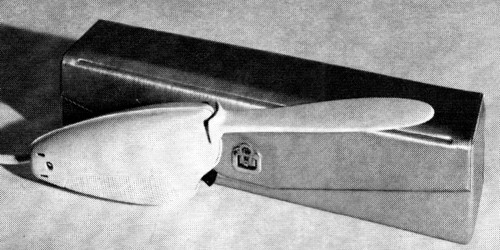
Above: 1968 Helena Rubinstein’s Pat-A-Glow. An electro-vibrator that gently pats the face at 1,800 strokes per minute to give the skin a ‘glowing vibrant look’.
Risks
Patters were not without potential problems. They needed to be used with enough force to make the skin pink so there was always a danger that they would damage the fine capillaries of the face; a prospect that appears to have occurred on at least one occasion.
Capillary Patches on Cheek
“K. 9.” writes: A patient has developed a capillary patch on each cheek following the use of a cosmetic face “patter.” The capillaries are too fine for treatment by electrolysis. Can anybody suggest a treatment for fading these patches? Are X-rays likely to be effective?(1935, BMA, p. 1240)
If the aim of using a patter was to induce a temporary increase in circulation there were simpler things one could do, such as apply warmth or use fingers to gently massage the face.
Updated: 22nd November 2017
Sources
American Medical Association. (1934). Journal of the American medical association. Chicago: Author.
McIntosh Battery and Optical Company. (1903). The skin. Its care and treatment. Chicago: Author.
Verni, M. (1946). Modern beauty culture (2nd ed.). London: New Era Publishing.
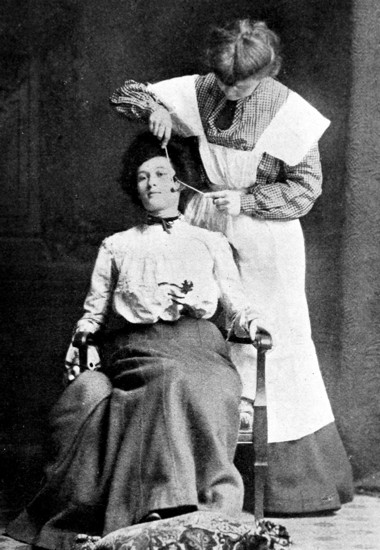
1903 Massage using mallets, an early type of patter.
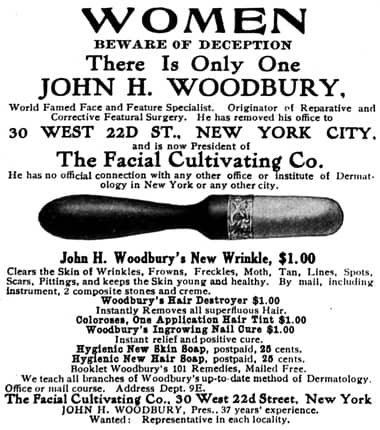
1908 Woodbury with a mallet/baton patter.
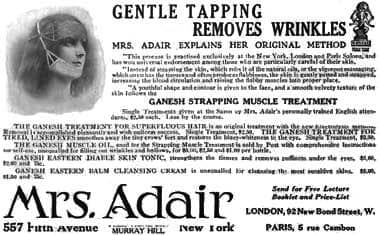
1913 Eleanor Adair. As with many other skin care practices, Elizabeth Arden picked up the idea of using patting rather than massage from Eleanor Adair with whom she had worked as a treatment girl.
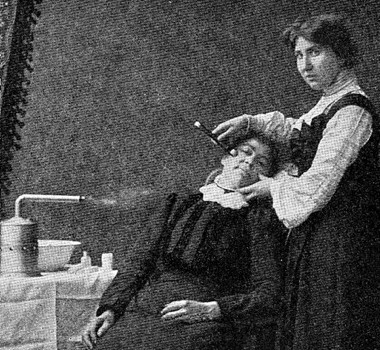
1919 This therapist appears to be using a double headed baton/patter during a steaming session.
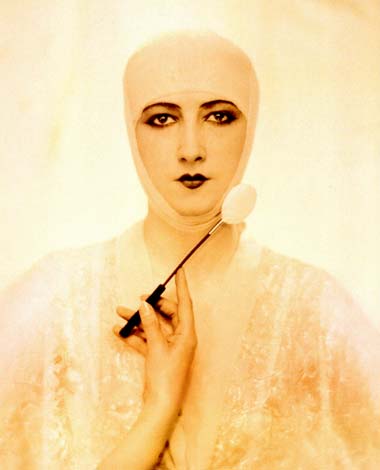
1927 A classic Elizabeth Arden photograph by Adolph de Meyer [1868-1946] with bandaged head and patter. Arden loved this pseudo-medical look.

An early Ardena Patter with box and instructions. Note the patter is to be used upward and outwards.
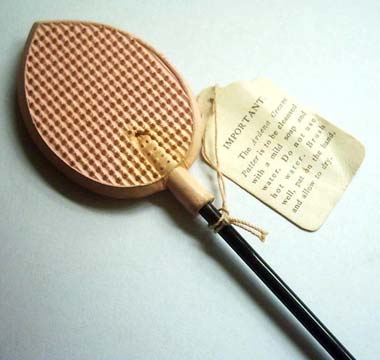
Back view of an Ardena Cream Patter with cleaning instructions.

1928 Dorothy Gray preparations and patter.
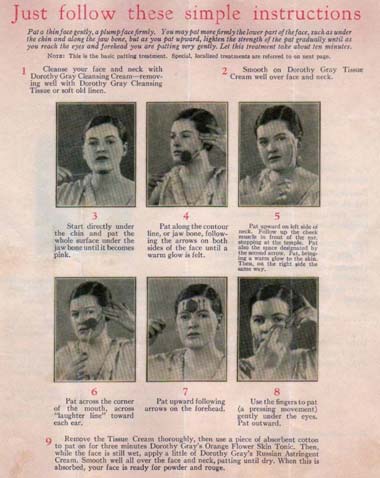
Part of the instructions for the use of a patter from Dorothy Gray. Although there are differences the principle is essentially the same as that from Elizabeth Arden.

1936 Patulator.
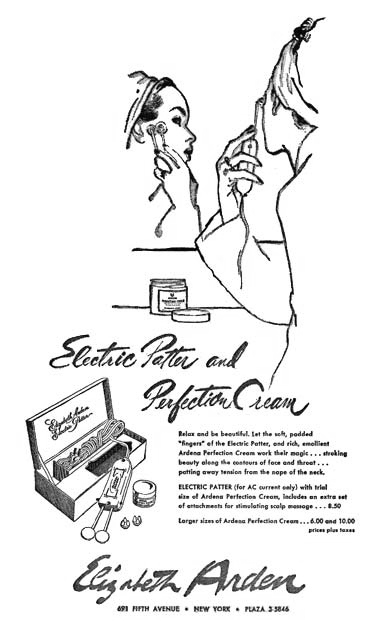
1947 The Arden Electric Patter made for Arden by the Connecticut Telephone and Electric Corporation who also sold it independently as the ‘Velvetskin Patter’. It came with flat pads as well as massage cups to “pat away tension”.
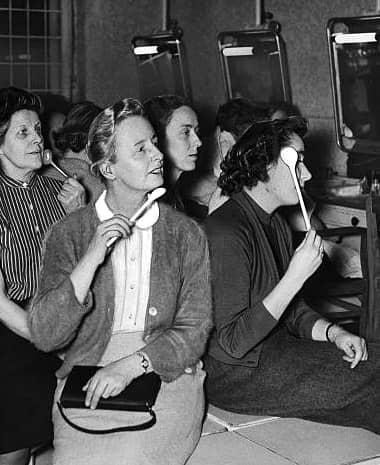
1957 Women at a beauty demonstration using wooden spoons as a patter.
